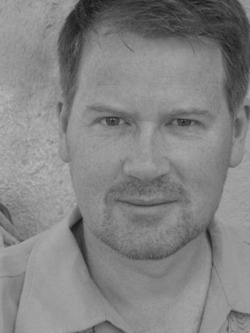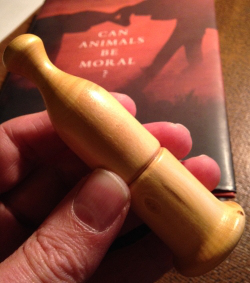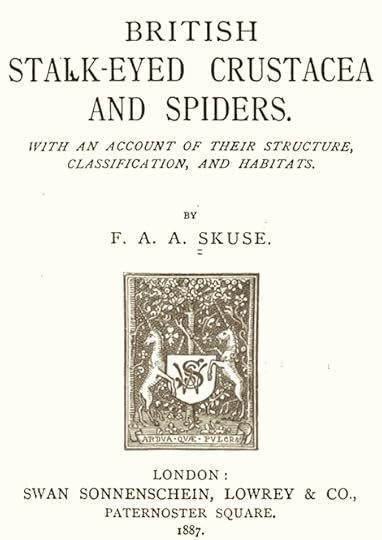Marc Abrahams's Blog, page 418
March 14, 2014
A closer look at the Blonsky Device in Dublin
The Science Gallery in Dublin produced this short video closeup of their full-scale model of the Ig Nobel Prize-winning Blonsky centrifugal birthing device:
For background on this see our February 21, 2014 report “The Blonsky centrifugal birthing device in Dublin“.

Tap dancing and the Osgood-Schlatter syndrome
Following on from a recent Improbable note which highlit research into Lower Extremity Kinetics in Tap Dancers, we can suggest to readers that just about any* kind of occupation or professional activity has the potential to cause discomfort and/or injury of some kind – and tap dancing is no exception. Despite its long history, however, it wasn’t until 2002 that the very first scientific appraisal of injuries amongst tap dancers was performed. A US-based research group surveyed advanced and master-class participants at the New York City Tap Festival. They found that tap dancers can suffer from various sprains (back, hip, thigh, knee &etc) as well as fractures (ankle & wrist) and even Osgood-Schlatter syndrome (a.k.a. apophysitis of the tibial tubercle, or knobby knees). The overall picture was quite reassuring though :
“We have found an apparent lower injury occurrence rate in tap dancers compared to other dance and athletic activity.”
But the team went on to caution that for a fuller picture, additional basic research might be needed.
“Limitations of our study include those implicit in a retrospective survey, difficulties of comparison with other studies, and the necessity for averaging the estimates of dance exposures for our cohort. In addition, we do not know the magnitude of selection bias introduced by the 47% response rate that we experienced. We believe that additional basic research using kinetic and kinematic data is required to explain our findings, and perhaps, to provide insight into injury prevention in other dance and sport activities.”
The research was published as : ‘The Prevalence of Injury Among Tap Dancers’ by Lester Mayers, M.D., Daniel Judelson, B.S., and Shaw Bronner, P.T., Ed.M, in the Journal of Dance Medicine & Science, Volume 7, Number 4, 2003, and can be read in full here:
* Note: If you can think of one that doesn’t, please let us know by commenting below.
Further reading : Studies of dance-related injuries in other genres ;
• Flamenco (1998)
• Ballroom (2001)
• Highland (2002)
• Irish (2006)
• Ballet (dancer-lifting by males) (2009)

March 13, 2014
Ig Nobel show (w duck opera) Friday at Imperial College
The 2014 Ig Nobel Tour of Europe begins Friday night, March 14, at Imperial College London. It features:
Marc Abrahams
Sue Gibson and The QI Elves performing Dramatic Improbable Readings from bizarre, genuine research reports
Mason Porter (Bipolar patients as oscillators)
Andrew George reciting the entire works of the bad poet McGonagall, or a portion thereof)
Ig Nobel Prize winner Kees Moeliker (homosexual necrophilia in the mallard duck, and its aftermath
Daniel Gillingwater and Sarah Redmond (and Kees Moeliker) in the world premiere of “The Homosexual Necrophiliac Duck Opera“
Details of the UK tour (and of this show), and of the Full tour schedule
TICKETS for this show [note: There might be a few tickets suddenly available at the last moment. If you want to take your chances on that, turn up at the door a bit before show time.)
BONUS: The next show, after this one, is Monday night, March 17, at the University of Warwick. TICKETS for that show.

Improbable on Loose Ends on Saturday
I’m going to be on the ‘Loose Ends‘ radio program on BBC 4 this Saturday night, March 15, talking about the new book This Is Improbable Too.
Clive Anderson is the host. The other guests are John Lloyd, who has been rather busy over the years (Not the Nine O’Clock News, Spitting Image, The Hitchhiker’s Guide to the Galaxy, Blackadder, QI, The Museum of Curiosity, and other things), actress Jenna Russell, pianist Bobby Crush, and singer Joan As Police Woman. This is a combination unseen in all of previous human history.

When mailing spiders, caterpillars, or cockroaches
QUESTION: When you mail live creatures, insects and invertebrates (including bees, caterpillars, cockroaches, crickets, destroyers of noxious pests, earthworms, fish fry and eggs, leeches and other parasites, lugworms, maggots, mealworms, pupae and chrysalides, rag worms, silkworms, spiders and stick insects) in the UK, must you box and package them?
The answer lies on page 26 of the Royal Mail‘s prohibition-and-restriction-packed “Prohibitions and restrictions in the domestic and international post“.
But if you are planning to mail venomous spiders, also see ”Proposals to amend the items listed under ‘Prohibitions’, ‘Restrictions’ in the United Kingdom Post Scheme April 2013“.
BONUS: Jeff Van Bueren’s “Postal Experiments“

March 12, 2014
Smellizing Cookies and Salivating
This month’s Smellizing Study of the Month is:
“Smellizing Cookies and Salivating: A Focus on Olfactory Imagery,” Aradhna Krishna [pictured here], Maureen Morrin, and Eda Sayin, Journal of Consumer Research, epub 2014.
The prolific Mary Ann Twist issued a press release about it:
Fashion magazines come pre-loaded with scratch-and-sniff panels for perfume and aftershave, but what about advertisements for foods like chocolate chip cookies and fresh-baked bread? According to a new study in the Journal of Consumer Research, when food advertisements combine a photo of food with an “imagined odor,” consumers both salivate more for the item and then consume it in larger quantities.
“We wondered whether both real and imagined food smells would enhance consumer desire for that product. Does the concept of smelling food make people salivate more and increase their desire to eat more than they normally would?” write authors Aradhna Krishna (University of Michigan), Maureen Morrin (Temple University), and Eda Sayin (Koç University)…

How volcanologists define “spatter”
Golden syrup might not be the first material to spring to mind if you were after an experimental analogue with which to investigate the effects of ‘spatter’ around typical Hawaiian basaltic volcano eruptions. But spring it did to the mind of researchers Sumner, Blake, Matela, and Wolff, as recorded in a 2005 paper for the Journal of Volcanology and Geothermal Research (Volume 142, Issues 1–2, 1 April 2005, pp. 49–65) simply entitled ‘Spatter’.
The authors first define ‘spatter’.
“We define spatter as an accumulation of originally hot, fluid pyroclasts, which agglutinate on landing. Very fluid magma clots may also splash on landing.”
And then go on to describe experiments in which blobs of semi-diluted Golden Syrup were photographically recorded as they were dropped in small amounts from a capillary tube onto a glass surface, and in large blobs via a 7cm diameter glass tube – from heights of up to 3 meters. The idea was to replicate the behaviour of molten blobs of lava falling from a great height.
“Despite its importance throughout the Solar System, the transformation from falling fluid clasts to coherent liquid (lava) has not previously been investigated in detail.”
The full paper, with photos, may be found here:
Many thanks for the assistance of Dr. Sumner (Department of Earth Sciences, The Open University, Milton Keynes, UK) who informs Improbable that golden syrup “… is an accepted analog for lava/magma modelling in the geological world.” Later papers include, for example ‘Relationships between volcano gravitational spreading and magma intrusion’ (Bull Volcanol (2012) 74:743–765) describing experiments in which researchers used a tank of golden syrup, pumped by gravity, to grow sugary volcano-ettes.
But, for Improbable, ‘who/when/where?’ questions are as yet unresolved regarding the first application of golden syrup as a volcanological research model. If anyone can help us, please comment below and let us know.

March 11, 2014
Skuse on British stalk-eyed crustacea & spiders
“Every living creature is said to have its use, its beneficial part to play in the economy of nature.” So says page 117 of the book British stalk-eyed crustacea and spiders: with an account of their structure, classification and habitats,written by F.A.A. Skuse, and published in 1887.

The Homosexual Necrophiliac Duck Opera
 The Ig Nobel Tour of Europe will kick off Friday, March 14th at Imperial College London. That night’s show will include the world premiere of “The Homosexual Necrophiliac Duck Opera” by composer Daniel Gillingwater.
The Ig Nobel Tour of Europe will kick off Friday, March 14th at Imperial College London. That night’s show will include the world premiere of “The Homosexual Necrophiliac Duck Opera” by composer Daniel Gillingwater.
My now classic 2003 Ig Nobel Prize winning paper (with about the same title as the opera) has made some people laugh-and-think and changed my life quite a bit, but I could not have imagined that it would inspire the performing arts. So I asked the composer about the creation and scope of his work. He answered me:
“I have set it for solo high voice, in this premiere performed by Sarah Redmond (playing your role, as witness and first [and only author]). The gender difference need not be an issue as you are an elegant and willowy specimen, much like Sarah. The scoring also includes clarinet quintet, the Edge Ensemble with Shaun Thompson on clarinet. We have a vocal chorus of four – soprano, alto, tenor and bass punctuating the section beginning ‘Rather startled, I watched …’ which is the final vivace section of a pseudo Mozartian aria.”
“The two male singers will also be portraying the mallard ducks in question, through the medium of contemporary dance. A tasteful re-enactment of the duck display, mixing flowing, poetic body movements and extreme sexual violence.”
 My excitement grew. The actual words of my Ig Nobel winning paper would be sung and the duck’s display re-enacted! I had to find a way to participate. So I convinced Daniel that I am a virtuoso at playing the ‘Duck Call’. He agreed immediately:
My excitement grew. The actual words of my Ig Nobel winning paper would be sung and the duck’s display re-enacted! I had to find a way to participate. So I convinced Daniel that I am a virtuoso at playing the ‘Duck Call’. He agreed immediately:
“Now this rarely used orchestral instrument will be in the heart of the whole work and serves to comment sardonically on the comparisons of this act of homosexual necrophilia and the state of western civilisation today.”
Although I do not read a note of music, I am extremely confident in my role.
Come, see and hear: Ig Nobel Tour of the UK, 14 March 2014, 18:00-20:00h: Imperial College, London (South Kensington Campus, The Great Hall, Sherfield Building): reserve tickets here.

March 10, 2014
Clowns and… crimes, insurance, botox, whatnot
The Manchester Evening News reports on a “Bizarre spate of clown-related crimes reported across region” (thanks to investigator Adam K. Olson for bringing it to our attention.):
Police dealt with 19 incidents involving people dressed as clowns last year, and most were no laughing matter. Disguised with colourful wigs and white facepaint, smiling crooks carried out bogus charity collections, vandalised property and even carried out robberies, an FOI has revealed. In one of the most serious incidents, recorded in Stockport last November, a man dressed as a clown threatened someone with a knife to steal their bicycle.
The newspaper categorizes these incidents by borough:
Rochdale – 6 including four of suspicious circumstances involving clowns
Stockport – 4 including highway disruption and criminal damage
North Manchester – 3 including one hoax call
Bury – 2 both suspicious circumstances
The other four calls were from Bolton, Tameside, south Manchester and Oldham respectively.
Clowns figure in modern life in ways often unappreciated by many non-clowns. Among those we have noticed:
Clown insurance
Clowns and kids and botulinum toxin
The ministry of clowns
Corporate tiers of a clown

Marc Abrahams's Blog
- Marc Abrahams's profile
- 14 followers







